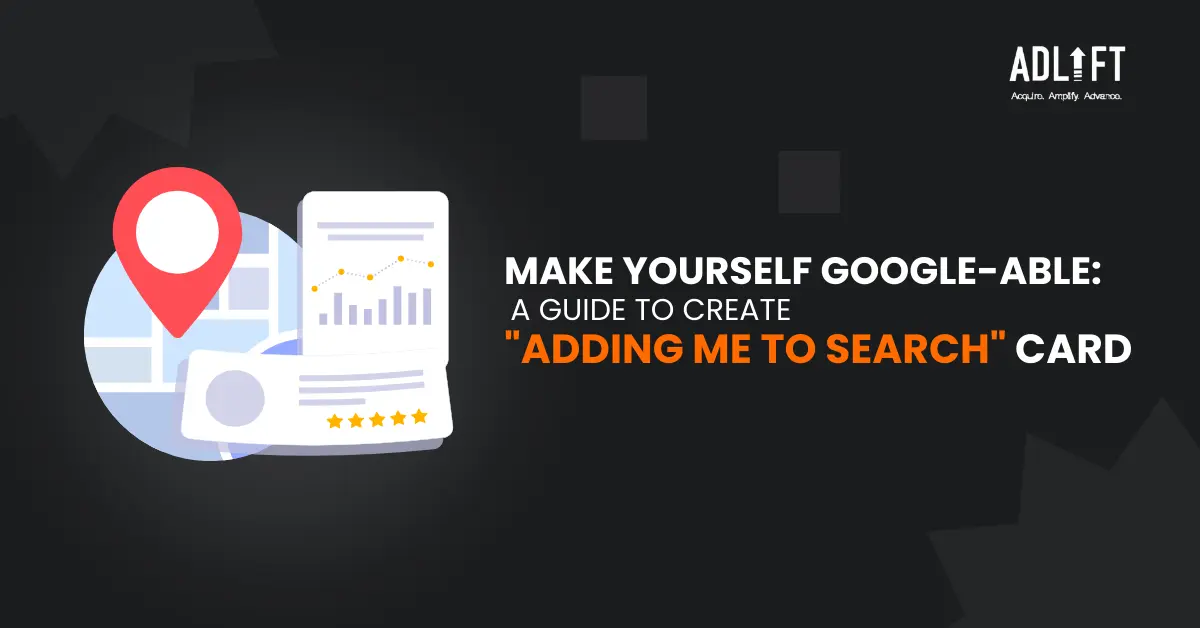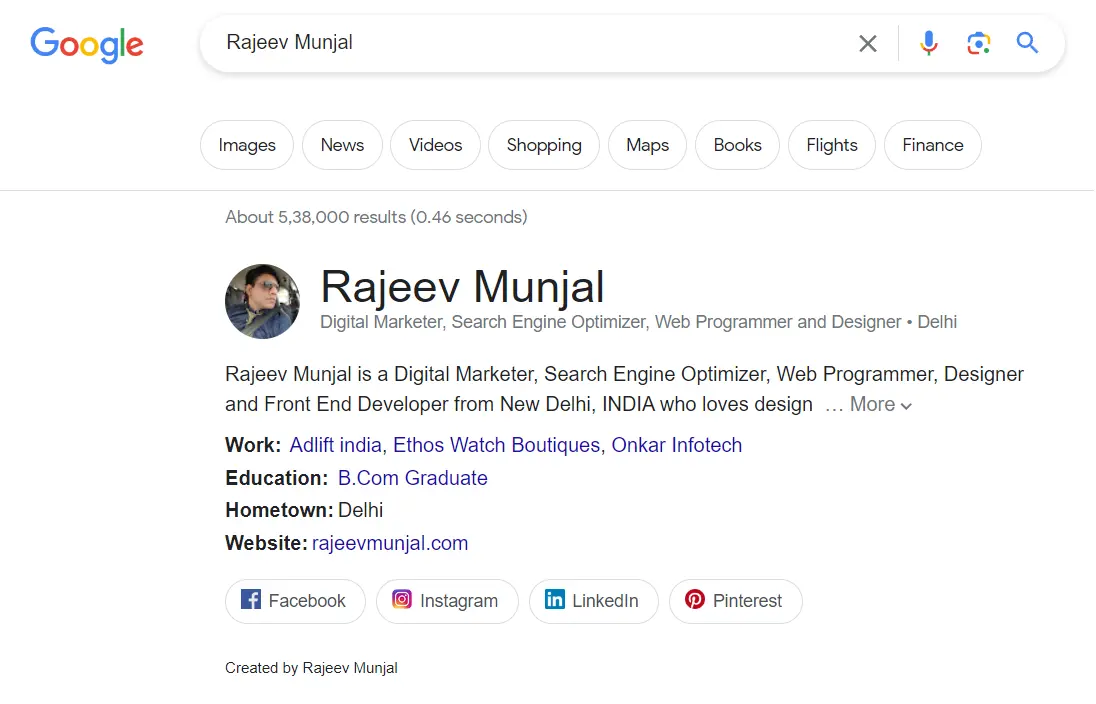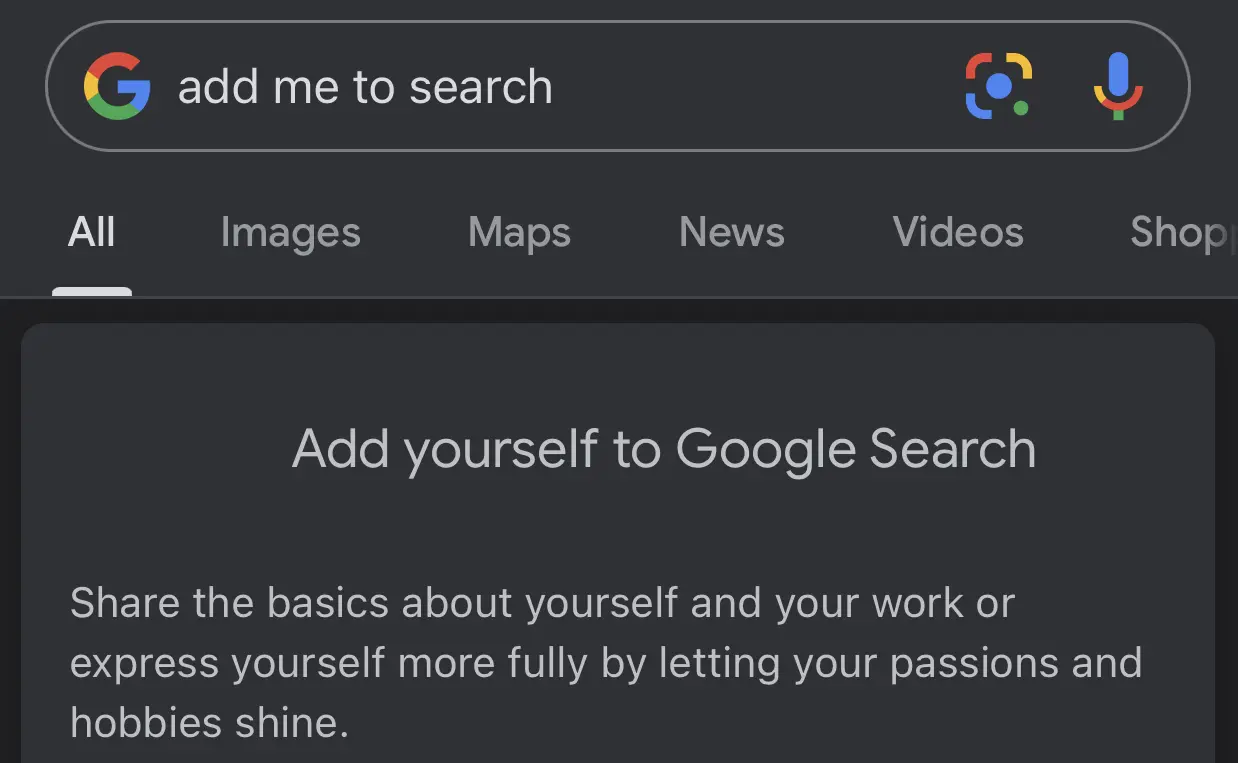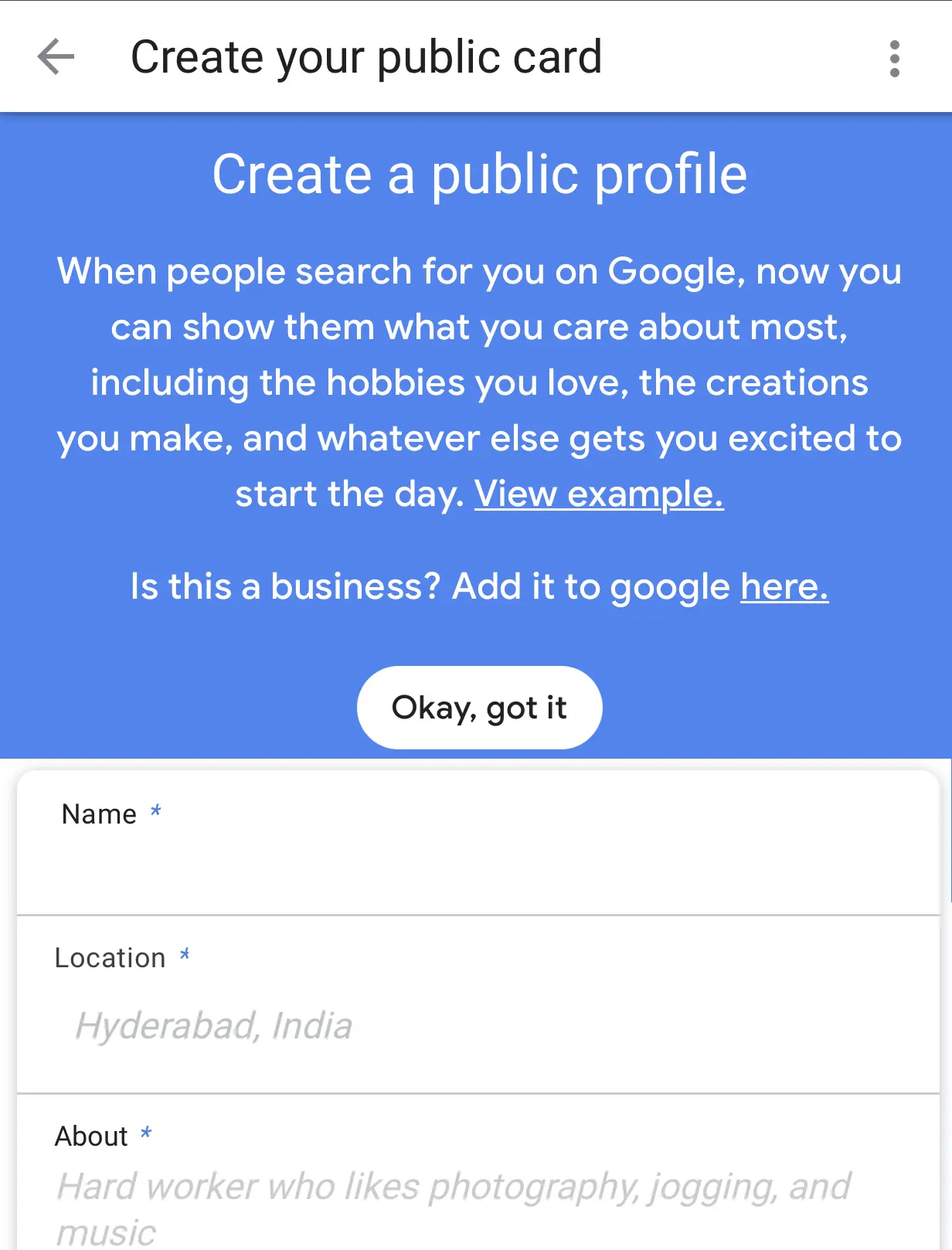Become Google-able: The Essential Guide to “Adding Me to Search”

Having a strong online presence is more important than ever. When someone searches for your name, what information do they find? Do they see a professional profile that reflects your skills and experience or a scattered mess of unrelated content?
Thankfully, Google offers a powerful tool to help you curate your online identity: the Google People Card or Add Me to Google Search. This virtual business card appears at the top of search results whenever someone searches for your name. It’s a fantastic way to showcase your expertise, connect with potential employers or collaborators, and control the narrative surrounding your online presence.
Allow us to guide you through the process of creating your own Add Me to Google People Card, step-by-step. Whether you’re embarking on your career journey or a seasoned expert, a carefully crafted People Card can significantly enhance your professional presence.
Update on Creating and Editing Add Me to Google Cards in 2025
With the discontinuation of Google People Cards, users can no longer create or edit these cards. The feature was retired on April 7, 2024, due to limited adoption and effectiveness.
Why Add Me to Google Card Wasn’t Widely Adopted
Several factors contributed to the limited adoption of Google’s People Cards:
- Limited Availability: Initially launched in India in 2020, the feature was later introduced in select African countries, including Kenya, Nigeria, and South Africa. However, it was not made available globally, restricting its user base.
- User Perception: Many users did not perceive significant value in creating a People Card, especially when other platforms already served similar purposes.
- Privacy Concerns: Sharing personal information publicly on search results raised privacy issues for some users, deterring them from using the feature.
Countries Where Google Launched Add Me to Google Cards
Add Me to Search Cards by Google were officially launched in select countries, with a gradual rollout focusing on regions with high mobile internet usage and emerging digital markets.
India
The initial launch of Google People Cards took place in August 2020 in India, making it the first country to have access to this feature. India was chosen as the launchpad due to its vast internet user base and the increasing number of individuals looking to establish a professional online presence. The feature aimed to help freelancers, entrepreneurs, and job seekers improve their visibility in Google Search.
Kenya, Nigeria, and South Africa
Following the Indian launch, Google expanded People Cards to three African nations—Kenya, Nigeria, and South Africa—later in 2020. This expansion aligned with Google’s strategy to support digital inclusion and personal branding in regions where mobile internet penetration was rapidly growing.
Despite its availability in these countries, Add Me to Google Cards did not see widespread adoption, leading to its eventual discontinuation in April 2024. However, the initiative highlighted Google’s ongoing efforts to provide digital identity solutions for individuals across emerging markets.
Alternatives of Google People Cards
With the discontinuation of People Cards, individuals seeking to enhance their online presence can consider the following alternatives:
- Google Business Profile: Formerly known as Google My Business, this platform allows businesses and professionals to manage their online presence across Google services, including Search and Maps.
- LinkedIn: A professional networking site where users can create detailed profiles, showcase experience, skills, and connect with other professionals.
- About.me: A personal landing page service that aggregates links to your content across the web, providing a centralized online presence.
- vCard: A digital business card format that can be shared electronically, containing your contact information and other relevant details.
By leveraging these platforms, individuals can effectively maintain and enhance their visibility on the web, ensuring that accurate and comprehensive information is accessible to those searching for them.
Also Read – Local SEO Checklist: Tips For Google Maps SEO
What is a Google People Card or Add Me to Search?
Think of your Google People Card as a digital resume that appears directly in search results. It allows you to provide basic information about yourself, such as your name, profession, and contact details. You can further add links to your website, social media profiles, or other relevant online content.
Here are some key benefits of having an Add Me to Search or Google People Card:
Increased Visibility:
When someone searches for your name, your People Card will appear prominently at the top of the search results. This can help potential employers, clients, or collaborators find you easily.
Enhanced Credibility:
A well-crafted People Card shows that you’re taking control of your online presence and are serious about your career or business. It can also help establish you as an expert in your field.
Improved Networking:
Your People Card provides a central location for potential connections to find your contact information and learn more about you. This can result in new opportunities and collaborations.
Control Over Your Online Narrative:
With a Google People Card, you can curate the information that appears in search results for your name. This allows you to ensure that potential connections see the most relevant and up-to-date information about you.
How to Create Your Google People Card?
Wondering how to add yourself on Google? Creating your Google People Card is a quick and easy process. Here’s what you need to do:
Search for Yourself:
Head to Google and simply type in your name in the search bar.
Look for the “Add Me to Search” Prompt:
If you’re eligible to create a People Card, you should see a prompt at the top of the search results that says “Add yourself to Search.” Click on the “Get Started” button. (Note: Currently, Google People Cards are only available in a limited number of countries. If you don’t see the prompt, you may need to wait until it becomes available in your region.)
Fill Out Your Information:
Google will provide you with a form to fill out with your basic information, including your name, profession, location (optional), and a summary of yourself.
Here are some tips for completing your information:
Keep it Professional:
While you can add a touch of personality, your People Card should primarily focus on your professional identity.
Use Keywords:
Infuse relevant keywords describing your skills and experience. This will help your People Card show up in search results for those keywords.
Be Concise:
Keep your summary short and to the point. Aim for 2-3 sentences that showcase your strengths and experience.
Add Links:
You can include links to your website, social media profiles, online portfolio, or any other relevant online content.
Preview and Save:
Once you’ve filled out all the information, take a moment to preview your People Card. Make sure everything looks accurate and professional. When you’re happy with it, click “Save” to publish your card.
Optimizing Your Google People Card
Once your People Card is created, there are a few things you can do to optimize it:
Keep it Updated:
Regularly review your People Card and update your information as your career progresses. Add new skills, update your contact information, and adjust your summary to reflect your latest accomplishments.
Engage with Your Profile:
Your Add Me to Google Search or People Card isn’t static – you can interact with it! Respond to reviews or answer questions that users may leave on your card. This can help establish your thought leadership and build trust with potential connections.
Get Recommendations:
Encourage colleagues, clients, or collaborators to leave positive reviews on your People Card. This can add social proof and make your profile even more impactful.
Creating a Strong Online Presence
Your Google People Card is a valuable tool for managing your online identity, but it’s just one piece of the puzzle. Here are some additional tips:
Develop a Professional Website:
A well-designed website showcases your skills, experience, and accomplishments in more detail than is possible on a People Card. It’s also a great platform to share your portfolio, blog posts, or other content that demonstrates your expertise.
Be Active on Social Media:
Utilize platforms like Twitter, LinkedIn, or industry forums to connect with potential employers, clients, or collaborators. Share pertinent content, join discussions, and engage in online communities to bolster your reputation and position yourself as a knowledgeable authority.
Ensure Brand Consistency:
Maintain a uniform brand identity across all online platforms, spanning from your People Card to your website and social media profiles. This includes using the same professional headshot, similar color schemes, and a clear, consistent message about who you are and what you do.
Here’s Where AdLift Digital Marketing Agency Can Help!
At AdLift, we recognize the significance of establishing a robust online presence. Offering a spectrum of services paid media, content marketing and SEO, we cater to diverse needs. With our seasoned experts, we craft customized strategies, guaranteeing a cohesive approach that drives you towards triumph.
Whether you need help crafting a compelling “Add Me to Search” or “Google People Card”, developing a professional website, or launching a strategic social media campaign, AdLift can be an invaluable partner in your online marketing efforts.
By following these tips and leveraging the power of your Google People Card, you can create a strong online presence, helping you connect with the right people and achieve your personal or professional objectives.
Ready to take control of your online narrative and build a thriving online presence? Contact AdLift today for a free consultation!
FAQs
The timeframe for changes appearing in Google search results can vary considering several factors, including the nature of the update and the keyword’s competitiveness. Minor adjustments, such as content updates or metadata tweaks, may reflect within days or hours. However, significant changes, such as website restructuring or algorithm updates, may take weeks or months to propagate and impact rankings.
Paid advertising allows businesses to gain immediate visibility and target specific audiences. While organic efforts are essential for long-term growth, paid advertising can boost visibility, especially for new companies or those looking to reach a broader audience quickly.
Absolutely! Social media profile optimization for search engines can positively impact your online visibility. Start by ensuring your profiles are complete, accurate, and consistent across all platforms. Incorporate relevant keywords into your profile descriptions, headlines, and posts to make them more discoverable in search results. Regularly posting engaging content and encouraging interaction can improve your search rankings.
Having a mobile-friendly website is essential for a seamless user experience and maintaining your search rankings. If your website needs to be mobile-friendly, consider redesigning it using responsive design principles. Responsive design ensures your website adapts to different screen sizes and devices, providing an optimal viewing experience for users across desktops, smartphones, and tablets. You can improve user satisfaction, increase engagement, and boost your search rankings by prioritizing mobile-friendliness.
Monitoring online reputation is crucial for brand credibility and promptly addressing issues. Start by utilizing online reputation management tools to monitor mentions, reviews, and social media conversations about your brand in real time. Regularly review customer feedback, respond to reviews, and handle any concerns or complaints professionally and transparently. With active online reputation management, you can strengthen customer trust, mitigate negative sentiment, and maintain a positive brand image.
Categories
- AI
- ChatGPT
- Content Marketing
- Content Marketing & Strategy
- Digital Marketing
- Entrepreneurship
- Google Analytics
- Google Tag Manager
- Google Updates
- Influencer Marketing
- Mobile App Marketing
- Paid Marketing
- Press
- Pubcon
- Search Engine Marketing
- Search Engine Optimization
- SEO
- SEO Tools
- Social Media Marketing
Recent Posts
- How do I Verify My Business on Google to Ace Local SEO? March 17, 2025
- The Pros and Cons of Pay For Performance SEO March 17, 2025
- Website Structure for SEO: A Blueprint for Better Rankings March 17, 2025
- Keyword Cannibalization: Why It Matters for Your Company and How to Avoid It March 12, 2025
- SEO for Bing: Unlocking Opportunities for Business Owners and Marketers March 11, 2025
- Google Cached Websites: A Quick Guide to Accessing Them March 5, 2025
- Programmatic Advertising: Stop Just Talking About It, and Start Driving Real Growth (A Business Leader’s Guide to Cutting Through the Hype) March 4, 2025
- How to Use Google Trends: The Ultimate Guide for SEO & Content Marketers March 4, 2025
- Farewell, Skype: It’s the End of an Era March 3, 2025
- How to Plan and Execute a Website Migration Without Losing Rankings? February 28, 2025
Get
in Touch
Contact AdLift for a 360-degree marketing plan






